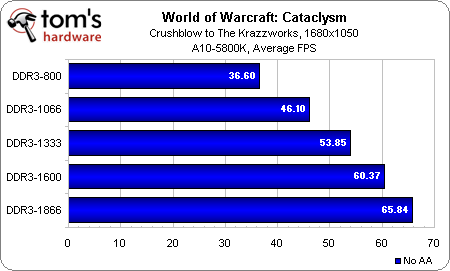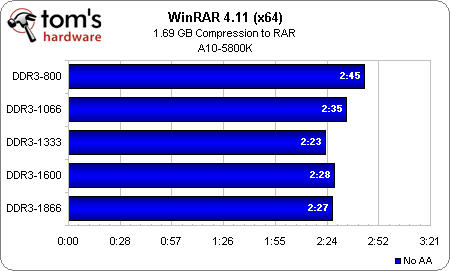AMD Trinity On The Desktop: A10, A8, And A6 Get Benchmarked!
Memory Bandwidth Scaling: Feed The Beast
It used to be that memory controllers built into chipset northbridges played a key role in determining system performance, making the modules you’d drop in an important consideration as well. But processor-based controllers have done a lot to maximize throughput. Two-, three-, and four-channel implementations designed to address high-end server workloads are generally overkill on the desktop.
As a result, it’s been a really long time since we’ve encountered a processor architecture starved for bandwidth. That’s bad news for memory vendors, who charge a premium for modules rated for higher data rates at lower latencies. After all, if cheap DDR3-1333 gets the job done, why worry about a kit capable of DDR3-2800?
The answer is integrated graphics.
Intel’s HD Graphics 4000 engine is fast enough to reflect moderate scaling as memory bandwidth increases. Before that, the Llano-based A8 APUs also demonstrated acute sensitivity to system memory data rates, justifying higher-end modules. And now, with Trinity, we get a purportedly higher-end graphics processor that’ll undoubtedly need to be fed even faster in order to realize its potential.
In response, AMD officially adds support for up to DDR3-2133 with one module per channel, or DDR3-1866 in one- and two-module-per-channel configurations. In comparison, Llano topped out at DDR3-1600. (Update: AMD clarifies that desktop Trinity-based APUs will max out with DDR3-1866 support).
In the SiSoft Sandra tests you’ll see shortly, the Trinity-based APUs yield less memory bandwidth from our 16 GB DDR3-1600 kit than Llano. But let’s see what happens when we replace those modules with Kingston’s new KHX2800OC12D3T1K2/4GX kit of two DDR3-2800 modules.
Although we’re only using two modules for this specific test, the ASRock FM2A75 Pro4 motherboard serving as our test platform won’t boot above DDR3-1866, limiting the scope of our early testing. Attempt to run at DDR3-2133 using manual parameters, or DDR3-2800/2666 using pre-programmed settings simply wouldn’t work.
Get Tom's Hardware's best news and in-depth reviews, straight to your inbox.
With that said, bandwidth doesn’t scale linearly, and gains are already tapering off by 1866 MT/s. We do, however, see AMD’s A10-5800K pick up modest bandwidth as data rates go up. How do those numbers correspond to a real-world gaming scenario?
Just as we were expecting, feeding Trinity with the right memory kit is going to make a huge difference in graphics-bound applications, in particular. And while the increases in average frame rate are great in World of Warcraft, the minimum frame rate numbers are even more meaningful. When performance dips to 21 FPS, it’s a totally different experience compared to 41 FPS.
The situation isn’t as compelling in WinRAR, which has historically demonstrated more sensitivity to memory bandwidth than any other application in our suite. Performance scales well through DDR3-1333, but as timings have to be loosened, higher latencies counteract the bandwidth increase, and WinRAR hits a ceiling of sorts.
Of course, the thing to remember is that this is a preview. It seems pretty clear that Trinity-based APUs are going to benefit from fast memory kits able to feed their Radeon graphics engines. What we don’t yet know, though, is whether motherboard vendors will be able to tune their firmware for stable operation at even higher data rates, allowing us to push some of the newest enthusiast-oriented kits.
Current page: Memory Bandwidth Scaling: Feed The Beast
Prev Page Graphics: Fewer Shaders, Better Efficiency Next Page Socket Compatibility And The A85X FCH-
Youngmind This is so exciting! AMD is probably going to dominate the lower-end and give the poor gamers like me more bang-for-buck as their IGP get better and better :)!Reply -
dudewitbow depending on how its priced, its a really nice alternative for bare budget gaming that opens up a quad core as wellReply -
So this means that a 'Crossfired' Trinity APU would beat ANY similarly-priced Intel (CPU+discrete GPU) ???Reply
Well at least in gaming -
dudewitbow JiggerByteSo this means that a 'Crossfired' Trinity APU would beat ANY similarly-priced Intel (CPU+discrete GPU) ???Well at least in gamingReply
really the question is what gpus are able to hybrid crossfire with it. the information was never public. not all amd gpus will hybrid crossfire with it. -
Well, where are the Ivy/Sandy i5's and i3's???Reply
Once they are pitted against each other, that will be A TRUE measure of the APU Trinity's marketability -
mayankleoboy1 in the OpenCL Winzip benchmark, when openCL is enabled the workload is done only by the iGPU or the CPU as well ?Reply
i mean what is the processor usage during the benchmark ? are all CPU cores used? or only one? -
cangelini mayankleoboy1in the OpenCL Winzip benchmark, when openCL is enabled the workload is done only by the iGPU or the CPU as well ?i mean what is the processor usage during the benchmark ? are all CPU cores used? or only one?Good question--I'll take a look for you.Reply




